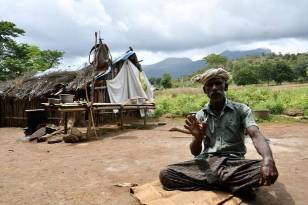 It was a common sight near 60-year-old Nanjan Ginbantan’s village, Anaikatty, which borders the Mudumalai Tiger Reserve near Masinagudi in Tamil Nadu. “Forty years ago, there were at least 500 to 1,000 vultures here. Three months ago, which was when I last sighted some, there were just 20 circling in the sky.”
It was a common sight near 60-year-old Nanjan Ginbantan’s village, Anaikatty, which borders the Mudumalai Tiger Reserve near Masinagudi in Tamil Nadu. “Forty years ago, there were at least 500 to 1,000 vultures here. Three months ago, which was when I last sighted some, there were just 20 circling in the sky.”
“What do you think caused the decline?” asks Chandrasekar S., a naturalist studying vultures, as his colleague Rangaswamy M. video-records the conversation. Vulture nesting sites, says Ginbantan, have decreased drastically. “For example, the 6-10 nests we always saw in Siriyur village till 2014 are no longer there.”
Ginbantan has other interesting insights into vulture behaviour. It’s not vultures, but crows that find carcasses first, he says; vultures note the aggregation of crows and then fly down to the dead animal.
Ginbantan’s intimate knowledge about the vultures of Masinagudi, passed down over generations or gathered from experience, is what Chandrasekar and his team are mining as part of the Sanctuary Nature Foundation’s Mud on Boots project that is trying to understand the decline of vulture population in the Nilgiris.
